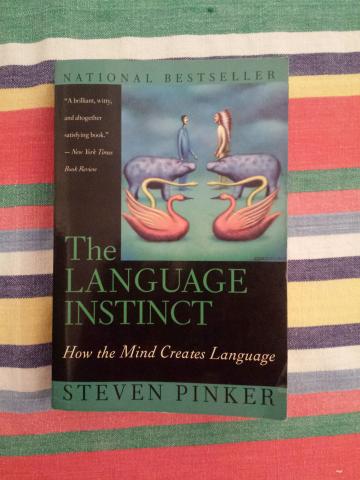Book Review: Steven Pinker's "The Language Instinct: How The Mind Creates Language"
Sep 10,2015
Considering the elementary, even mundane nature of them, it is not at all surprising that many people get through the day without giving a second thought to the words that come out of their mouth, from the pen they use, or from the keys they push. How did we come up with the sounds that create words? Why do we associate particular ones with certain objects or ideas? Where do they even come from? Such questions rarely arise in day-to-day life, but for the times they do, many likely conclude that humans simply made them up over time as they saw fit. It's not the most in-depth explanation, but it is certainly a fair guess for the average layperson. Fortunately, none other than esteemed cognitive scientist and Harvard psychology professor Steven Pinker has taken it upon himself to offer a rigorous explanation for the mechanics and development of human language in The Language Instinct: How The Mind Creates Language, albeit one that contrasts irreconcilably with the "just so" explanation settled upon by individuals without formal training in linguistics or psychology. Rather, Pinker posits that language is a phenomenon with an indisputably biological basis, itself a result of evolution nudging humanity along towards a refined form of communication over countless millennia. Drawing from various disciplines and thinkers and writing in an accessible but firmly matter-of-fact manner, Pinker excellently defends his argument and illustrates his points, all in a way that doesn't scare off the previously-mentioned layperson.
However, our hypothetical layperson is in very good (and, in Pinker's eyes, very wrong) company, for the "Standard Social Science Model" (Pinker, pg. 23), or the notion that the human mind (and thus human language) is essentially nothing more than a lump of clay in the hands of society and culture, is taken for granted in most academic circles, particularly those involving fields such as anthropology and sociology. While it might be considered tenable within the quarters of it's acolytes, the Model has an unfortunate tendency to not only insert itself into hard science fields where the incessant refrain that "[blank] is a social construct" holds little to no water (you wouldn't say "Gravity is a social construct," would you?), but to also rely on dubious evidence, as Pinker amply demonstrates. Nowhere is this more evident than in his rebuttal of the notorious Sapir-Whorf hypothesis, advanced by Edward Sapir and Benjamin Lee Whorf and long held up by adherents of linguistic determinism as proof that environment dictates language and language in turn dictates thought. For evidence, they pointed to studies carried out by Whorf purporting to find that the language of the Apache, with it's odd, often-imprecise descriptions of events, and Hopi Indians, with it's lack of words designating exact times and dates, were fundamentally different from English because the lives of Apache and Hopi Indians were fundamentally different from English-speaking people. There is one small problem with Whorf's claim though, as Pinker points out: "Whorf did not actually study any Apaches; it is not clear that he ever met one. His assertions about Apache psychology are based entirely on Apache grammar - making his argument circular. Apaches speak differently, so they must think differently. How do we know they think differently? Just listen to the way they speak!" (Pinker, pg. 61). In the case of the Hopi, Whorf's argument that they do not think of events as distinct occurrences and dates as quantifiable entities crumbles when Pinker challenges: "What, then, are we to make of the following sentence translated from Hopi?: 'Then indeed, the following day, quite early in the morning at the hour when people pray to the sun, around that time then he woke up the girl again'," (Pinker, pg. 63). In short, Whorf was, as he might have claimed the Apache would say, communicating verbally by movement out of his, or somebody's, rear end.
Other myths about language are no more safe from the scrutiny of Pinker's razor-sharp pen. He debunks the "Great Eskimo Vocabulary Hoax" (Pinker, pg. 64) - that is, the oft-repeated claims that the Inuit, due to the major role snow plays in their lives, have an extensive number of words for it - with as much skill as he did the Sapir-Whorf hypothesis, showing that no respectable linguist or anthropologist has ever come forward with data suggesting anything even remotely close to the reported dozens upon dozens of Inuit cognates for snow. The actual number, as it turns out, is commonly accepted to be a dozen, which, when compared to the choice English speakers get to make between sleet, blizzard, hail, and several others when discussing snow, is not nearly as astounding as the Hoax made it out to be. What is astounding though, is the motive that drove trained academics to push such blatantly false assertions as scientific fact. "Linguistic relativity came out of the [Franz] Boas school, as part of a campaign to show that nonliterate cultures were as complex and sophisticated as European ones. But the supposedly mind-broadening anecdotes owe their appeal to a patronizing willingness to treat other cultures' psychologies as weird and exotic compared to our own," Pinker expounds (Pinker, pg. 64). People like Whorf, Sapir and the pushers of the Great Eskimo Vocabulary Hoax might very well have had good intentions: indeed, many people who lie to others imagine they do so. But when the truth comes out and the lie falls apart, the liar's intentions are forgotten and everyone else suffers for it, as countless people do when they parrot inaccurate stories about Native American tribes with no concept of time and a surplus of words for snow to others.
So if people don't think in words, what do they think in? According to Pinker, "We end up with the following picture. People do not think in English or Chinese or Apache; they think in a language of thought," (Pinker, pg. 81) or what he later refers to as a "universal mentalese" (Pinker, pg. 82). This is because when we think of a given objects, the first thing that comes to mind isn't the word, it's the object itself: only afterwards do we attach the appropriate word to it. Furthermore, the relation between the objects when we think of them is much more abstract than the relation between said objects and concepts when we try to verbalize or otherwise communicate them. This is because spoken and written language requires clear delineation of boundaries between objects so that others may understand what the speaker or writer is trying to convey. Others are not privy to the inner workings of the speaker/writer, but thanks to language, they have a powerful tool to communicate their thoughts. However, while language may indeed be a tool rather than the driving force linguistic determinists hold it to be, it is not a tool that can be used whichever way one sees fit. For instance, "Grammar is a protocol that has to interconnect the ear, the mouth, and the mind, three very different kinds of machine. It cannot be tailored to any of them but must have an abstract logic of it's own," (Pinker, pg. 125), meaning that the way we structure sentences is a self-contained phenomenon, operating only one correct way without regard for our ability to verbally or mentally improvise new, incorrect structures. True, one might dissent and point to irregular words as evidence against Pinker's case for structured, finely-tuned language, but it would behoove them not to, for as it turns out, "irregularity is tightly encapsulated in the word-building system," (Pinker, pg. 141). People don't call each other lowlives: they call each other lowlifes (Pinker, pgs. 142-143). They don't call their personal sound systems Walkmen either: they call them Walkmans (Pinker, pg. 142-143). Why? Because the speaker senses the irregularity, the "headlessness" (Pinker, pg. 143) of the word. They sense that the noun in the word, or the head, is false, meaning that they don't have to render the word as they would if it actually were the noun in question. The fact that even people little academic training are able to correctly render such challenging words without much thought testifies to not only the awe-inspiring complexity of language, but the innate nature of it as well.
While there may still be much to learn about the human brain and the role it plays in creating language, Pinker gives us a fascinating glimpse into what is known about this relationship. In a segment on the division of labor between the left and right hemispheres of the brain, Pinker refers readers to a study of deaf people with aphasia, a linguistic disorder caused by damage to the brain. Since the disorder inhibits speech, one could be forgiven for assuming that deaf people, many of whom are now able to communicate in sign language, would be unaffected for the most part. This, as we learn, is absolutely not the case: the study reveals that deaf people with damage to the left hemisphere of their brains struggle as much with signing as hearing aphasics do with speaking and writing (Pinker, pg. 302), indicating that not only can –and does - language take nonverbal forms, but also that it can be localized to the left hemisphere. “The left hemisphere must be handling the abstract rules and trees underlying language, the grammar and the dictionary and the anatomy of words, and not merely the sounds and the mouthings of the surface,” Pinker surmises (Pinker, pg. 302). The ramifications are staggering. Language does not simply come about because people will it: it comes from something much deeper, something honed by hundreds of thousands of years of adaptation. The sheer amount of components that go into the process – grammar, irregularity, morphemes, and many, many more – are impressive enough, but the thing they build is truly a triumph of evolution, a triumph that allowed humans to advance beyond being just another type of primate and live to see the achievements of their offspring. To put it as Pinker does, “The language instinct, like the eye, is an example of what Darwin called ‘that perfection of structure and co-adaptation which justly excites our admiration,’ and as such it bears the unmistakable stamp of nature’s designer, natural selection,” (Pinker, pg. 362).
Some might suspect that this review barely skims the surface of Pinker’s tome. Believe it or not, they’re right: an in-depth analysis that does justice to Pinker’s work would in all likelihood take the form of a paper published in an obscure academic journal, something beyond the average reader’s attention span and frankly, this reviewer’s capabilities. What this reviewer can tell you though is that if you take it upon yourself to read it and stick to it, you will come out knowing a great deal more about language, how it works, and where it came from, than you might have thought possible. It truly is a privilege for Pinker, rightfully considered by many to be one of the preeminent minds of our time, to share his carefully considered, pragmatic analysis of such an important part of our existence, a privilege compounded by the clear, stimulating way in which he presents information, data, and his own observations. Readers interested in linguistics, psychology, or who are just looking for something that's both enlightening and enjoyable would be wise to go with their gut and check out Steven Pinker's The Language Instinct: How The Mind Creates Language.






